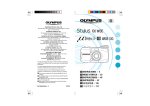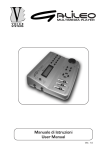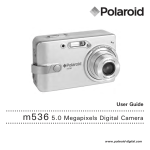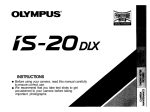Download Olympus 3000 DLX Digital Camera User Manual
Transcript
INSTRUCTIONS Before using your SuperZoom3000DLX, read this manual carefully to ensure correct use. We recommend that you take test shots to get accustomed to your SuperZoom3000DLX before taking important photographs. Thank you for purchasing the Olympus SuperZoom3000DLX. MAIN FEATURES Built-in 38mm ~ 110mm 3X zoom lens. Weatherproof Remote control (optional) Versatile functions including AF-P mode to ensure that approaching subjects are in focus. Quarts date or time imprinting. Symbols used in this manual: 2 Incorrect Manual operation Next operation Operation order Automatic operation Operation sound Indicator on Indicator blinking Attention Depress halfway Names and functions of parts …… 4 PREPARATIONS BASIC OPERATIONS Viewfinder display/LCD panel …… 6 Diopter adjustment ....................... 7 Using the strap............................... 8 Unloading the film ···························································· Using the flash modes ·················· 25 10 12 13 14 16 18 23 Infinity............................. 35 Double exposure .................... 36 Using the subject modes ··············· 29 Spot ···································· 30 Selftimer Auto-Zoom Printing the date and time..............40 Correcting the data ........................41 ······························ 32 Night Scene ······························ 33 AF-P.............................................. CAMERA MAINTENANCE ·········· Loading the batteries ········· Checking the batteries ······· Points to remember ············ Loading the film ...................................................................................................... Taking pictures ················································································ Menu selection ······························ 24 ADVANCED TECHNIQUES Outline of operations 34 ································· 38 Remote control (optional) ..............39 Caring for your weatherproof camera................................... 42 Questions and answers 44 ................................................ Care and storage...................................................................................................... 45 Battery handling ...................................................................................................... 46 Troubleshooting ..................................................................... Specifications ......................................................................... 47 50 3 NAMES AND FUNCTIONS OF PARTS MENU SELECT dial (See p. 24.) Shutter release button Date indicator LCD panel Displays the camera's mode and operation conditions. (See p. 6.) PREPARATIONS (See p. 15.) Power ON/OFF Selftimer indicator switch (See p. 18.) Flash Autofocus windows Light sensor Strap eyelet Zoom buttons (See p. 19.) Viewfinder 4 Lens zooms in — telephoto. zooms out — wide-angle. Diopter adjustment Selftimer / remote control Viewfinder (See p. 6.) Control (See p. 7.) button (See p. 38.) Mid-roll rewind button (See p. 23.) MENU button (See p. 24.) Film window Back cover release MODE and SET buttons for date unit (See p. 40 / 41.) Tripod socket Back cover Battery compartment cover 5 VIEWFINDER DISPLAY/LCD PANEL Viewfinder Display Close-up correction marks At a close distance, your subject must be positioned within the close-up correction marks. Orange lamp Lights when the flash will fire. Autofocus mark Position your subject within the autofocus Green lamp mark. Lights when the subject is in focus. Auto-zoom (p. 32) LCD Panel Flash modes (p. 25) Selftimer/remote control (p. 38 / 39) Battery check (p. 13) Exposure counter (p. 17) Night scene (p. 33) AF-P (p. 34) Double exposure (p. 36) Infinity (p. 35) Spot (p. 30) Normal 6 DIOPTER ADJUSTMENT To Adjust the Viewfinder to Compensate for Near- and Farsighted Vision. Turn the diopter adjustment control until the viewfinder display becomes clear. Turn to the left if you are farsighted or to the right if you are nearsighted. 7 USING THE STRAP Attaching the Strap 8 Using the Soft Case (optional) The optional remote control can also be attached to the loop on the outside of the case. 9 OUTLINE OF OPERATIONS Basic Shooting Procedures 10 Load the batteries (p. 12). Open the back cover (p. 16). Load the film (p. 16). Press the zoom buttons for telephoto or wide-angle Place the autofocus mark on the subject you want to take a picture of (p. 19). Depress the shutter release button halfway to make sure the green lamp lights (p. 20). photography (p. 18). Close the back cover (p. 17). (p. 18). Make sure the exposure counter on the LCD panel reads / (p. 17). Depress the shutter release button When the film reaches the end, it Open the back cover to remove fully to take a picture (p. 20). will automatically rewind (p. 23). the rewound film (p. 23). Set the ON/OFF switch to ON 11 LOADING THE BATTERIES Turn the battery cover to with a coin. Press firmly to remove the battery cover. Use two 3V lithium batteries (CR123A or DL123A). Before loading the batteries, set the ON/OFF switch to OFF. 12 Insert the batteries, Replace the battery cover. Turn the battery cover back to to lock in place. Be sure the batteries are aligned correctly as shown. Read "Battery Handling" on page 46. CHECKING THE BATTERIES Set the ON/OFF switch to ON. Batteries are OK. The mark disappears after 12 sec. Batteries are low. Have spares handy. Batteries should be replaced immediately. 13 POINTS TO REMEMBER Hold the Camera Correctly. Correct. Correct. Hold the camera firmly with both hands. In the vertical position, hold the camera with its flash positioned at the top. 14 Incorrect. Caution: Keep your fingers away from the lens, flash, autofocus windows and light sensor. Proper Shutter Release. Practice before loading the film. Depress the shutter release button halfway Depress the shutter release button fully Cautions: •Press the shutter release button gently •Avoid shaking the camera when pressing the shutter release button to prevent blurry To lock the focus. The green lamp lights in the viewfinder. To release the shutter and take the picture. 15 LOADING THE FILM BASIC OPERATIONS Slide the back cover release upwards to open the back cover. 16 Insert the film cartridge, making sure the film is lying flat. Correct Incorrect Align the film leader with the red mark,and close the back cover. The film automatically advances to the first frame. Set the ON/OFF switch to ON. The exposure counter on the LCD panel reads Note: If blinks in the exposure counter, as shown above, reload the film. 17 TAKING PICTURES Set the ON/OFF switch to ON. The lens protector opens, the lens extends slightly, and the LCD panel activates. 18 Aim the camera at your subject. Use the zoom buttons for telephoto or wide-angle photography. How to Use the Zoom Buttons Telephoto: Press the button to zoom in. Position your subject within the autofocus mark. Max. telephoto focal length: 110mm Wide-angle: Press the button to zoom out. Max. wide-angle focal length: 38mm Autofocus mark The zoom speed varies according to the pressure applied to the zoom button. 19 Depress the shutter release button halfway. Depress the shutter release button fully. The film automatically advances to the The green lamp lights. 20 next frame. This camera has a built-in multiautofocus system, which automatically focuses on the subject even in compositions such as the one shown on the right. When the subject is not in the center of the viewfinder, it may be necessary to use the Spot mode (p. 30). 21 Working Distance Close-Up Correction Picture frame Close-up correction marks The focus range of the camera is 0.6 m (2 ft) to (infinity). When the subject is closer than 0.6 m (2 ft), the shutter will not release. (The green lamp blinks.) When the subject is extremely close to the camera, the subject will be out of focus although the shutter releases. 22 Image area of picture at 0.6 m (2 ft) The viewfinder's picture frame is the area that can be shot of subjects at (infinity). However, the picture area will move lower in the viewfinder as you get closer to the subject. At 0.6 m (2 ft), the shaded area is the actual available image area. In this case, the subject should be positioned below the closeup correction marks. UNLOADING THE FILM The camera automatically rewinds the film when you reach the end of a roll. Rewinding the film before the end of the roll After the motor stops and starts blinking on the LCD panel open the back cover and remove the film Press the mid roll rewind button with the tip of a ballpoint pen or the like. Do not use an instrument with a sharp tip. Note The final number of exposures may sometimes exceed the number of exposures specified on the fiIm 23 Engage the Flash Modes and MENU SELECTION ToSubject Modes ADVANCED TECHNIQUES When you press the MENU button... The menus of the flash modes and subject modes will be alternately displayed on the LCD panel. The engaged mode will blink. 24 When you turn the MENU SELECT dial with the MENU button pressed The modes in each menu will change in order. Release your finger from the MENU button to select the mode. USING THE FLASH MODES This camera has four flash modes Select the flash mode according to your shooting conditions and needs Follow the procedure on page 24 to display and engage the flash modes The flash mode changes in the order shown on the right Mode Function Automatically fires in low light and backlit conditions (p. 26) Significantly reduces the phenomenon of red eye (when a subject's eyes appear red) (p. 27) The flash does not fire (p. 28) Fires regardless of available light (p. 28) Notes AUTO-S wiII not be canceled when the power is turned OFF All other modes wiII return to the AUTO mode In the Auto and Auto-S Flash modes the flash strength is automatically controlled to prevent pictures from being overexposed even when the subjects are close 25 AUTO (Auto Flash) In the Auto Flash mode, the flash will fire automatically in low-light and backlit conditions. Flash Working Range ISO Wide (38mm) Tele (110mm) 100 0.6m~5.9m (2ft~19.4ft) 0.6m~2.8m (2ft~9.2ft) 0.6m~8.3m 0.6m~3.9m (2ft~27.2ft) (2ft~12.8ft) 0.6m~11.8m 0.6m~5.6m (2ft~38.7ft) (2ft~18.4ft) 200 The orange lamp in the upper right of the viewfinder lights when the shutter release button is depressed halfway 400 Note: In some situations such as when the subject is too small occasionally the flash may not fire automatically even in the backlight (This is more likely to occur with telephoto ) If this occurs use the FILL IN mode 26 AUTO-S (Red-Eye Reducing Flash) Significantly reduces the phenomenon of "red-eye" (when a subject's eyes appear red) In the Auto-S Flash mode, the camera will emit a series of low power pre-flashes before the regular flash. This makes the subjects' pupils contract significantly reducing red eye. Except for the pre- flashes, this mode is the same as the Auto Flash mode. Note: Red eye reduction may not be effective with some individuals or if the subject wasn't watching the pre-flashes. IMPORTANT: Be sure to hold the camera still until the shutter releases 27 OFF (Flash Override) (Forced Activation) When you don't want the flash to fire, even in the dark When you want to fire the flash every shot In the Flash Off mode, the flash does not fire even in low light conditions. Use this mode in situations where flash photography is not desired or is prohibited. In the Fill-In Flash mode, the flash fires regardless of available Iight. This mode can be used to brighten up a subject's shaded face, for example. Note Since a slow shutter speed (down to 2 seconds) is automatically selected in low-light situations the use of a tripod is recommended to prevent blurred pictures caused by shaking the camera 28 FILL-IN USING THE SUBJECT MODES The cameras seven subject modes offer a variety of functions Follow the procedure on page 24 to display and engage the subject modes The subject mode changes in the order as shown on the right Functi on Mode Spot (p. 30) You can focus and set the exposure for the main subject Auto Zoom (p. 32) You can keep the subject's head and shoulders framed in the viewfinder Night Scene (p. 33) You can capture a night scene beautifully AF-P (p. 34) You can focus on subjects approaching the camera lnfinity (p. 35) You can shoot distant subjects like mountains clouds and fireworks Double Exposure (p. 36) You can combine the images on a single frame Notes When the power is turned OFF and ON again the camera returns to the Normal mode When the Normal mode is engaged NORMAL on the LCD panel wilI disappear 29 SPOT To Focus and Set the Exposure for the Main Subject Engage the Spot mode and position the autofocus mark on your subject Press the shutter release button halfway In the case above the camera will focus on the flowers in the foreground and the mam subject will be out of focus when shot in the normal mode 30 The green lamp lights Reposition your subject in the picture frame while keeping the shutter release button depressed halfway. When the shutter release button is pressed halfway, the focus and exposure will be locked in the center of the autofocus mark. Depress the shutter release button fully to take the picture. The use of the Spot mode is recommended in the following cases. When there is an object in front of the main subject. When the subject is on the edge of the frame. When the background is brighter than the subject (the subject is backlit). 31 Keep the Subject's Head-andAUTO-ZOOM To Shoulders Framed in the Viewfinder Engage the Auto-Zoom mode, and press the shutter release button halfway The lens will automatically zoom until the frame is filled with an adult's head and shoulders When the lens stops zooming, press the shutter release button fully Even in the Auto Zoom mode it is possible to use the zoom button Note Outside 1.3 ~ 3.9 m (4.3 ~ 12.8 ft) the subject won't be zoomed in to the frame as specified 32 NIGHT SCENE To Capture a Night Scene Beautifully Engage the Night Scene mode. Any flash mode can be combined with the Night Scene mode. When in the Auto, Auto-S, or Fill In mode: When in the Flash-Off mode: Both the subject in the foreground and the The night scene will be properly exposed. night scene will be properly exposed. Note: Since a slow shutter speed (down to 2 seconds) is automatically selected in low-light situations, the use of a tripod is recommended to prevent blurred pictures caused by shaking the camera. 33 AF-P To Focus on a Subject Approaching the Camera. Engage the AF-P mode. Aim the camera at the approaching subject Press the shutter release button. Notes The Auto-S mode cannot be combined with the AF-P mode. If the AF-P mode is engaged in the Auto-S mode, the flash mode will change to Auto and return to Auto-S when the AF-P mode is canceled. The focus will be adjusted according to the movement of the subject AF-P mode working distance: 0.6 ~ 4m (2 ~ 13 ft) 34 Selftimer/Remote control cannot be used in the AF-P mode. The camera focuses only on the center of the autofocus mark so make sure not to let the center of the autofocus mark shift from the subject. The orange and green lamps won't light when you press the shutter release button halfway However if the shutter release button is pressed before the flash is recharged or outside the working range (less than 0.6 m/2 ft) the respective lamp will blink and the shutter will be locked. Moving subjects may be blurred even when in exact focus. INFINITY To Shoot Distant Subjects Like Mountains, Clouds, and Fireworks Engage the Infinity mode. Aim at the subject Press the shutter release button. Notes The flash mode will automatically change to Flash Off. When the Infinity mode is canceled, the flash mode will return to the previous mode. When the shutter release button is pressed halfway the exposure will be locked. The working distance will be set at infinity. 35 DOUBLE EXPOSURE To Expose Two Images on a Single Frame Engage the Double Exposure mode. Press the shutter release button to take the first exposure. The film will not advance on the LCD panel will blink. 36 Take the second exposure. The film will advance and the Double Exposure mode will be disengaged. Note: After the first frame has been exposed, the Double Exposure mode cannot be canceled by switching off the power. To cancel it after the first shot, follow the procedure on page 24 to change the mode. 37 SELFTIMER To Put Yourself in the Picture Press the /REMOTE button. is displayed on the LCD panel. Notes: The focus and exposure wiII be locked when the shutter release button is depressed halfway. 38 Aim at your subject, and press the shutter release button. The shutter will be released 12 seconds later. After the shutter is released, the camera wiII return to the Normal mode. To cancel the selftimer after it has been activated, press the /REMOTE button again. REMOTE CONTROL (optional) Press the /REMOTE button. is displayed on the LCD panel. Aim the remote control at the camera, and press the button. The shutter will be released after 3 seconds. After shooting, press the / REMOTE button again to cancel the selftimer/remote control mode. Notes: Use the remote control within the above range. The camera will focus on the subject directly in front of it. 39 PRINTING THE DATE AND TIME Choose the desired mode with the MODE button. No data Year-month-day Month-day-year Day-month-year Day-hour-minute The mode will switch in the described order by pressing the MODE button. 40 The quartz date shares the power source with the main unit. Make sure to correct the data after the batteries are replaced. The data is imprinted in the lower right of the picture. If there is something whitish or tinged with orange where the data is imprinted, the data may be difficult to read. CORRECTING THE DATA Press the MODE button for two seconds or longer. The year indication will start blinking. Press the mode button again to choose the data to be corrected until it starts blinking. And press the SET button to correct the data. If you press the button once, the number on display will advance by 1. And if you keep it pressed, the numbers will run through in rapid succession. Note: As you press the mode button, the blinking indication changes in the order of year, month, day, hour, and minute. The data correction will be finished when the mode button is pressed again. 41 CARING FOR YOUR WEATHERPROOF CAMERA CAMERA MAINTENANCE This camera is weatherproof. However, it is not designed for underwater use. Please note the following warnings and use the camera correctly. Splashing water 42 At the seaside Rain Do not submerge the camera or attempt to take pictures underwater. Do not wash the camera. Rubber gaskets are located inside the rear of the camera. Check the gaskets for wear and carefully remove any sand and dust to maintain a weatherproof seal. If the camera has been splashed by water, etc., clean the camera with a dry cloth as soon as possible. Do not touch the rubber gasket on the battery compartment cover or the rubber gasket on the camera back with excessive force. Do not remove the gaskets. Gaskets should be replaced after approximately three years, although they may require replacement earlier than that depending on use and wear. If the gaskets are damaged or need replacement, contact your nearest Olympus service center. 43 QUESTIONS AND ANSWERS Q: How long will the batteries last? A: If you use 24 exposure rolls of film and use the flash on half of all your pictures two new 3V lithium batteries (DL123A/CR123A) will last for 30 or more rolls of film If you do not use the flash and zoom very often the batteries will last much longer. Q:How should I clean the lens? A: Wipe the lens gently with a soft clean cotton cloth that has been moistened with a small amount of lens cleaning fluid. Q: Can I use film that is not DX coded? A: Yes but only ISO 100 film. Q: When does the camera measure and set the exposure? A: When the shutter release button is depressed halfway the camera measures both the exposure and focus and locks 44 them as long as the shutter release button remains halfway depressed. Q: Why did my camera make a loud noise and retract the lens right after I replaced the batteries? A: Because you replaced the batteries while the power was on Be sure to switch off the power before replacing the batteries. Q: Can the battery in the optional remote control be replaced with a new one? A: No it cannot be replaced but lasts about 8 years. CARE AND STORAGE CAUTIONS DO NOT EXPOSE THE CAMERA TO EXTREME HEAT (OVER 40°C/104°F) OR TO EXTREME COLD (BELOW -10°C/14°F) AVOID SUDDEN TEMPERATURE CHANGES AND HUMIDITY DO NOT EXPOSE THE CAMERA TO STRONG MAGNETIC FIELDS DO NOT APPLY EXCESSIVE FORCE TO THE CAMERA OR ITS CONTROLS DO NOT TOUCH THE CONTACT POINTS INSIDE THE CAMERA DO NOT USE ORGANIC SOLVENTS THINNERS OR BENZINE TO CLEAN THE CAMERA AVOID STRONG IMPACT CAUSED BY BUMPING OR DROPPING THE CAMERA DO NOT IMMERSE THE CAMERA IN WATER DO NOT EXPOSE THE CAMERA TO EXCESSIVE DUST AND SAND DO NOT EXPOSE THE CAMERA TO THE COLD WHEN IT'S WET OR THE LENS PROTECTOR ETC MAY FREEZE, MAKING THE CAMERA INOPERABLE. THE LENS BARREL IS FINISHED WITH A SPECIAL COATING TO SMOOTH THE ZOOMING MOVEMENT NEVER WIPE IT WITH SOLVENTS LIKE THINNERS OR BENZINE WHEN IT IS HEAVILY STAINED CLEAN IT WITH A MOISTENED CLOTH AND THEN WIPE OFF THE MOISTURE WITH A DRY CLOTH WARNING NEVER ATTEMPT TO DISASSEMBLE THE CAMERA; IT CONTAINS A HIGHVOLTAGE CIRCUIT. In case of malfunction consult your nearest Olympus dealer or Olympus service center. 45 BATTERY HANDLING NOTES Even when batteries are brand-new, their service life may be shorter than specified if an extended period of time has passed since they were produced. Do not mix different types of batteries or new and old batteries. Keep spare batteries on hand when going on a long trip or to a cold area. Sweat and oil can prevent a battery's terminals from making electrical contact. To avoid this wipe both terminals before loading batteries. 46 WARNINGS NEVER TRY TO DISASSEMBLE, RECHARGE, OR SHORT CIRCUIT BATTERIES. NEVER EXPOSE BATTERIES TO EXCESSIVE HEAT. KEEP THE BATTERIES OUT OF THE REACH OF CHILDREN. IF A CHILD SWALLOWS A BATTERY, CONTACT A DOCTOR IMMEDIATELY. USE TWO 3V LITHIUM BATTERIES (CR123A OR DL123A). NEVER TRY TO DISASSEMBLE OR MODIFY ANY BATTERY OR BATTERY PACK FOR USE IN THIS CAMERA. TROUBLESHOOTING OPERATING PROBLEMS Symptom The camera does not work. terminals is not correct. The batteries are exhausted. The batteries are temporarily unable to function. The loaded film has been rewound. The film is incorrectly loaded. The LCD display turns off suddenly. Remedy Cause The power is OFF The alignment of the battery The LCD display turns off after four and a half minutes if the camera is not used. Set the ON/OFF switch to ON. See p. 18 Reload the batteries correctly. p. 12 Replace the batteries with new ones. Keep the camera warm while using it. p. 13 Load new film. Reload the film. Turn the power off and then on again p. 23 p. 17 or press the shutter relase button halfway to turn on the LCD panel. In addition, the power is turned OFF automatically after 4 hours. When the camera is not in use, keep the power OFF as much as possible. The shutter doesn't release when the remote control's shutter release button is pressed. The remote control hasn't been used in the 15 minutes since the Selftimer/ Remote Control mode was entered, causing the LCD panel to turn off. Press the zoom button, The LCD will light, Then press the /REMOTE button again. 47 Symptom 48 Cause The green lamp blinks, and the shutter will not release. The orange lamp blinks, and the shutter will not release. The camera is closer than 0.6 m (2 ft) to the subject. The flash does not fire, even in the dark. The flash mode is set to OFF. The camera is in the Infinity mode which overrides the flash. Symptom The picture is out of focus Cause The camera moved when the shutter release button was pressed. The subject was not within the viewfinder's autofocus frame. The lens and autofocus windows were dirty. The autofocus window was blocked, such as by a finger. The flash has not been recharged yet. Remedy Move the camera farther than See p. 22 0.6 m (2 ft) from the subject. Remove your finger from the shutter release button and wait for several seconds until the flash is recharged before shooting. Set it to a mode other than OFF. Cancel the Infinity mode, or set the flash mode to one other than OFF. Remedy Hold the camera correctly and press the shutter release button gently. Position the subject in the center of the autofocus mark, or use the Spot mode. Clean the lens and autofocus windows. Hold the camera correctly, keeping your fingers clear of the autofocus windows. p. 25 p. 35 See p. 14 p.21/30 p. 14 PROBLEMS WITH THE PRINTED PICTURES Symptom The picture is out of focus. The picture is too dark. The date has not been printed (or looks faded). Cause The subject was closer than the minimum working distance to the lens (0.6 m/2 ft). While using the self-timer, the shutter release button was pressed while standing right in front of the camera. The Infinity mode is engaged. A difficult subject for the autofocus to lock on was shot. These subjects include: glossy and reflective surfaces, black objects, subjects behind glass or wire mesh, flames and smoke, excessively bright light within the picture area. The flash was blocked, such as by a finger. The subject was out of the working range of the flash. The flash mode was set to OFF. The subject was backlit. The date mode was set to no data( - - - ). There is a bright color like white, orange, or yellow in the area of the Remedy Shoot from more than 0.6 m (2 ft) away from the subject. See p. 22 Do not stand in front of the camera. Press the shutter release button while looking through the viewfinder. Cancel the Infinity mode. Shoot distant subjects in the Infinity mode. When the subject is near, first focus on an object at the same distance as the desired subject in the Spot mode. Then aim at the desired subject and release the shutter. p. 38 p. 29 p. 30/35 Hold the camera correctly, keeping your fingers clear of the flash. Shoot within the flash working range. p. 14 Check the flash mode before shooting. Set the flash mode to FILL-IN. Change the date mode to another setting. Avoid bright colors in the lower right corner of your photo compositions. p. 25 p. 26 p. 28 p. 40 picture where the date is printed. The picture was taken with Do not use black-and-white film. black-and-white film. 49 SPECIFICATIONS Type: Full automatic 35mm autofocus lens-shutter camera with built-in 38~110mm zoom lens. Film format: 35mm standard DX-coded film (24 X 36 mm) Remote control (optional): Infrared remote control Lens: Olympus lens 38~110mm F3.8~8.1, 10 For film with less than ISO 50, film speed is set to ISO 100. Film loading: Automatic loading. (Automatically advances to first frame when camera back is closed). Film advance: Automatic film winding. Film rewind: Automatic film rewind (automatic rewind activation at end of film, automatic rewind stop). Rewind possible at any point with rewind button. Flash: Built-in flash. Recycling time: Approx. 0.2 ~ 3.8 sec. (at normal temperature with new batteries). Flash working range: Wide-angle — elements in 8 groups. Shutter: Programmed electronic shutter. Viewfinder: Kepler type zoom viewfinder (with autofocus mark, close-up correction marks, autofocus indicator and flash indicator). Diopter correction possible. Focusing: Active-type multi-autofocus system. Focus lock possible. Focusing range: 0.6 m (2 ft) ~ (infinity). Exposure control: Programmed automatic exposure control. 3-zone light metering, switchable to spot metering. Auto exposure range: Wide-angle — film with ISO 50, 100, 200, 400, 800, 1600, 3200. 0.6 ~ 5.9 m (2 - 19.4 ft), Telephoto — 0.6 ~ 2.8 Telephoto — EV5.1 (F8.1, 2 sec.) to EV18.4 m (2 ~ 9.2 ft) with ISO 100 color negative film; Wide-angle — 0.6 ~ 11.8 m (2 ~ 38.7 ft), (F26, 1/500 sec.). Telephoto — 0.6 ~ 5.6 m (2 - 18.4 ft) with ISO EV2.9 (F3.8, 2 sec.) to EV16.2 (F12, 1/500 sec.), Exposure counter: Progressive type with automatic reset, displayed on LCD panel. Selftimer: Electronic selftimer 12-sec. delay. 50 unit with 3-sec. delay. Film speed range: Automatic setting with DX-coded 400 color negative film. Slow-Synchro: possible with longest shutter speed of 2 sec. Flash modes: AUTO (Automatic flash activation in low-light and backlight). AUTO-S (Red-eye reducing, in low-light and backlight). OFF (No flash). FILL-IN (Forced activation). Battery check: Displayed on LCD panel. Weatherproof: IEC Standard publication 529. Classification of degrees of protection provided by enclosures. Degrees of protection indicated by the second characteristic numeral 4 Short description: Protected against splashing water Definition: Water splashed against the enclosure from any direction shall have no harmful effect Test for second numeral 4: The equipment is sprayed from all practical directions. The water pressure is adjusted to give a delivery rate of 10 lit./min. The test duration shall be 1 min. per m 2 of calculated surface area of the enclosure with a minimum duration of 5 min. (DL123A/CR123A). Dimensions: 133(W) X 68(H) X 56(D) mm (5-1/4X2-11/16X2-3/16in) (without protrusions). Weight: 305 g (10.8 oz) (without batteries). SPECIFICATIONS FOR DATE UNIT Imprinting direction: Data imprinted onto film from lens side. Data coding: No data, year-month-day, month-dayyear, day-month-year and day-hour-minute. External indication of data: Data display on liquid crystal panel. Film speed setting: Automatic film speed setting. Automatic calendar system: Up to year 2020. Power source: Ordinarily used with camera body. Power source: Two 3V lithium batteries SPECIFICATIONS ARE SUBJECT TO CHANGE WITHOUT ANY NOTICE OR OBLIGATION ON THE PART OF THE MANUFACTURER. 51 OLYMPUS OPTICAL CO., LTD. San-Ei Building, 22-2, Nishi Shinjuku 1-chome, Shinjuku-ku, Tokyo, Japan. Tel. 03-3340-2211 OLYMPUS AMERICA INC. Crossways Park, Woodbury, New York 11797-2087, U.S.A. Tel. 516-364-3000 OLYMPUS OPTICAL CO. (EUROPA) GMBH. (Premises/Goods delivery) Wendenstrasse 14-16, 20097 Hamburg, Germany. Tel. 040-237730 (Letters) Postfach 10 49 08, 20034 Hamburg, Germany. OLYMPUS OPTICAL CO. (UK.) LTD. 2-8 Honduras Street, London EC1Y 0TX, United Kingdom. Tel. 071-253-2772 PRINTED IN JAPAN 1093. 23MM































































